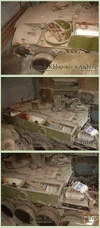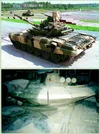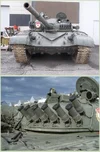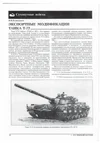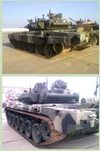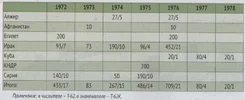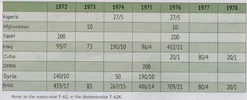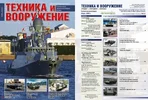Antares
Respected Leader
Otetaanpa tämä varalta talteen. En mene takuuseen luotettavuudesta, mutta ainakin sivusto on kyproslainen / sivuston pääte on kyproslainen.
Lainaan vain Kyproksen T-80U ja T-80UK vaunujen määriä ja aikatauluja koskevan osan sekä huvin vuoksi artikkelissa jaetun Youtube-videon: LÄHDE
Cyprus initially bought from Russia 41 T-80U (‘U-uluchsheniye’ meaning improvement in Russian) of which 27 were T-80Us and 14 T-80UKs (Commander version) all featuring the same powerplant with a jet-engine. The total cost of that deal was $ 174 million. The tanks arrived in Cyprus in two batches. The first shipment included 27 T-80Us that arrived in 1996, while the second batch of 14 T-80UKs arrived in 1997.
In 2010 the Republic of Cyprus proceeded to a new purchase of 41 refurbished T-80Us and four Brem-80U armored recovery vehicles for $ 115 million. The delivery of these tanks was completed in mid-2011. All T-80U tanks exported by the Russian Federation to Cyprus were part of the Russian’s army stock, while the Brem-80Us were built in Omsk exclusively for the National Guard (N.G).
-
Lainasin aikaisemmassa viestissä S. Ustyantsev kirjan tietoja, joiden mukaan Omskin tehdas valmisti viimeiset T-80 panssarivaunut vuonna 1996. LINKKI
JOS kyseinen tieto pitää paikkansa, se tarkoittaisi että Kyprokselle vuosina 1996 ja 1997 toimitetut vaunut olivat käytännössä uustuotantoa tai ainoastaan muutaman vuoden vanhoja (ehkä jopa niin että Kyptoksen tilaamat vaunut ovat viimeiset, jotka valmistuivat Omskin linjalta), mutta vuonna 2010 toimitetut vaunut olivat Venäjän varastoista (koska Omskin tehdas oli mennyt konkurssiin jo useita vuosia ennen tätä kauppaa). Ylle lainatun mukaan ne olisivat kuitenkin olleet peruskorjattuja (refurbished) kuten on yleensä niissä tilanteissa kun Venäjä myy vanhoja "varastovaunuja" ulkomaisille asiakkaille eli nämä vaunut käyvät jossain armored repair plant pajassa peruskorjattavana ennen vientiä.
Tämä on tietysti ollut tiedossa jo aikaisemmin, kunhan muistutan asiasta.
Hieman lisätietoa / tiedonmurusia Kyproksen T-80U panssarivaunuista.
Tämä artikkeli on arkistoitu 26.7.2011 mutta alkuperäinen lähde on todennäköisesti vanhempi: LÄHDE
More T-80U for Cyprus
The Republic of Cyprus deposited ten per cent (10%) of the total contract value for the acquisition of forty-one (41) T-80U main battle tanks from the Russian Federation. According to ISDA's information, Nicosia has paid the advancement during the Cyprus parliamentary delegation visit to Moscow, in October 2009. The Cyprus delegation was lead by the President of the House of Representatives Marios Garoyian and during its stay had meetings with numerous high-level Russian officials, including the Prime Minister of the Russian Federation Vladimir Putin and the President of the State Duma Boris Gryzlov.
It should be noted that the National Guard expressed the need to acquire an additional battalion of T-80Us in order to complete the nominal strength (82 MBTs) of the XX Armored Brigade. For financial and operational reasons, Nicosia decided to purchase second-hand T-80Us, which have already been inspected by Cypriot National Guard officers and were found to be in perfect condition. The expected MBTs will be delivered after the completion of some modifications that will bring them to the same level with the systems that are currently in service in Cyprus. The EUR 110 million contract provides also the option for the procurement of another forty-one (41) additional T-80Us, while the delivery of the tanks will be completed within 18 months from the activation (October, 2009) of the contract. However, it should be remembered that so far Cyprus had "frozen" the T-80U main battle tank acquisition program since, according to estimations, any purchase of such a magnitude could "disturb" the negotiation process between the Cyprus government and the Turkish-Cypriot community.
-
Otan varalta talteen kuvakaappauksen:
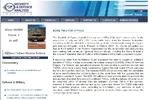
Sivun reunassa mainostetaan Hellenic Defence Monitor Bulletin, Issue 2, Vol. 1, December 22, 2009 - eli tämä nettisivun uutinen voi olla joko web-versio ko. julkaisun lyhyestä uutisesta, tai muuten vain samalta ajalta.
Linkittämässäni vanhemmassa viestissäni lainattiin kyproslaista nettisivua, jolla kirjoitettiin näin:
In 2010 the Republic of Cyprus proceeded to a new purchase of 41 refurbished T-80Us and four Brem-80U armored recovery vehicles for $ 115 million. The delivery of these tanks was completed in mid-2011.
Tämä vihjaa siitä että yllä lainattu i-sda.org artikkeli olisi joko vuodelta 2009 tai 2010, koska Kypros oli maksanut vaaditun 10% "käsirahan" ja odotti toimitusten alkamista. Maksu tapahtui lokakuussa 2009 kun delegaatio vieraili Moskovassa.
-
Tämä seuraava lainaus on Army recognition nettisivulta ja he eivät tietysti kerro lähdettään (artikkeli julkaistu 4.10.2021, alleviivaus minun): LÄHDE
Besides aging Frenc-made AMX-30B2s apparently still in the inventory, 27 T-80Us and 14 T-80UKs were ordered in 1996 from Russia. The T-80Us were delivered in 1996 and the T-80UKs were delivered in 1997. In 1999, a planned order for 41 additional T-80U/UK type tanks was canceled due to political sensitivities.
In 2009, the Cyprus National Guard was to equip with a further 41 T-80U/UK type tanks from Russian suppliers, with a pre-agreement reportedly made for a further 41 tanks of the type. The deal was previously erroneously reported to consist of Russian T-90 tanks.
-
Otin tämän talteen lähinnä mielenkiintoisena tiedonmurusena, joka odottaa parempaa lähdettä. Helppo uskoa että tuo voisi pitää paikkansa ja muut lainaamani artikkelit kommentoivat myös että Kypros halusi alunperin 82 kpl T-80U ja T-80UK panssarivaunuja, mutta toinen 42 kpl erä saatiin vasta 2010-2011. Ne eivät sano suoraan että panssarivaunut olisi haluttu hyvin pian ensimmäisten erien jälkeen, mutta jos raha ei ollut este niin helppo uskoa että ne olisi kyetty toimittamaan 90-luvulla, ehkä juuri 1999 kuten Army recognition nettisivun artikkelissa väitetään.
-
Tässä vielä yksi mielenkiintoinen lainaus aikaisemmin jakamastani kyproslaisesta Defence Redefined -nettisivun artikkelista (artikkeli on julkaistu 28.2.2021): LÄHDE
In any case, the international best practice favours the upgrade and utilization of tanks in their “half-life” (about 20 years) for satisfactory operation for a lifespan between 40-50 years, or even more in some cases (i.e. the M48 which made its debut in the 1950s) . The most common upgrade option includes the upgrade of the Fire Control System, the electro-optical sensors as well as the tank’s armor.
The first series of the N.G’s T-80Us, as said earlier, has already completed 25 years of service on the island. The second batch of refurbished tanks has already completed a decade of operational use with a total lifespan of about the same years as the first batch of T-80Us. The only upgrade that the Cypriot T-80Us had so far is the optoelectronics systems, which have been modernized in Cyprus with systems offered by the Belarusian JSC Peleng in collaboration with the French Thales (sources refer to Catharine-FC thermal imager).
-
Olen nähnyt toisinaan väitteitä että tämä modernisaatio olisi toiminut innoittajana / rahoittajana ryssän T-80UE-1 projektille. Se täsmäisi ajanhetken osalta, tosin T-80UE-1 on muutakin kuin pelkkä T-80U + lämpötähtäin.
Cypriot T-80U's parading in 2022.
Unlike regular T-80U's, these one have 2nd gen thermal.
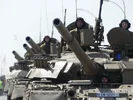
-
Viestin kommenteissa häneltä kysyttiin tällaista: Thales Thermals?
Johon T-90K vastasi näin: Bingo.
Toinen kommentoija vastasi jakamalla tämän kuvan:
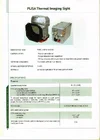
-
HUOM: ei ole selvää, onko tämä lämpötähtäin asennettu myöhemmin niihin 42 kpl ensimmäisessä erässä toimitettuun panssarivaunuun VAI löytyykö tämä ainoastaan 42 kpl toisessa erässä toimitetusta panssarivaunusta.
Ylempänä lainattu Defence Redefined -nettisivun artikkelin teksti ei sano asiaa suoraan ja se on tulkittavissa miten kukakin haluaa.
Viimeksi muokattu:



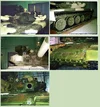
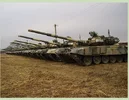

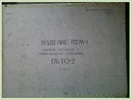
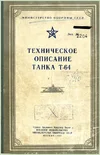

 )) .
)) .